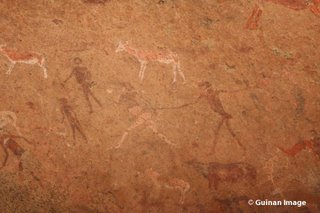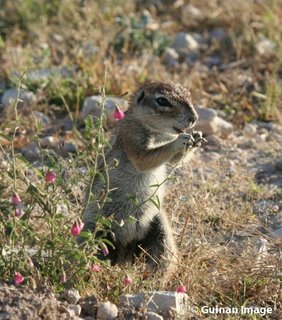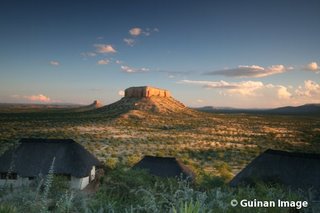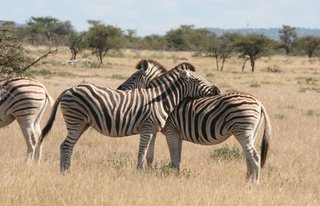Thursday, May 25, 2006
Visiting the White Lady
The petrol station was something of a revelation; poverty exposed in way we hadn't seen before. Lots and lots of people squatting or slouching in the shade, most with no apparent connection to an actual vehicle. Poor clothes - patches and holes - and one quite young man who had lost the vision of his right eye to a cataract. We immediately attracted the attention of several men carrying scalpels and nuts on strings: these men scrape a living of sorts by cutting scenes of wildlife on the side of these nuts, and adding the names of tourists to make a personalised souvenir. Competition was fierce - as soon as the secret of our names was out, several heads were bent in concentration as they carved; we had had absolutely no intention of buying any such thing, but ended up purchasing from 3 men nuts with the names of various friends and family, swayed by a combination of their pitiful clothes, their desperation, and the memory of the Red Cross aid station we'ld passed a block or so back. Glad to leave town: we'ld felt a little besieged.
Moving south, we found an increasingly parched landscape; the large farms of the east now replaced by modest little holdings, the imposing gates and long drives exchanged for ramshackle farmhouses within sight of the road. A parallel traffic system is operation, with the (very occasional) pickup truck using the main highway (a gravel road of generally good quality) and donkey carts using tracks on either side of the main road. Beautiful scenery, dominated by the Brandberg Massif, but a very tough climate - we crossed only a single bridge in a whole day's driving - hundreds of kilometres. There are plenty of rivers on the map, but these are, almost without exception, bone dry. We did encounter some wet sumps (bring a 4x4) but the road is mostly very good. Very little traffic; despite this, the roadside in the vicinity of the Ugab river is full of souvenir stalls operated by ladies in spectacular traditional dress.
Arriving at the White Lady turn-off, we were stopped in our tracks by four or five skinny little children who wanted in the first instance to get water, and in the second to trade food for rock crystals. We filled their bottle, and promised to return later - which we did, swapping biltong for an embarrasingly generous amount of rock crystal. Big heartbreaking smiles from the shoeless, shirtless children.
Reaching the car park at the foot of the mountain, we paid our entrance fee - for which we received the services of a guide. Covered in insect repellent and sun screen, we began the 45 minute hike to the paintings only after swilling enormous quantities of water - the heat of the afternoon in that windless ravine was, if not furnace-like, at least oven-like. Our guide turned out to be excellent - as well as living near by, he had studied the geology, flora, fauna, and history of the mountain, and was able to enlighten us on subjects ranging from basaltic outcroppings to life cycle of the enormous tadpoles swimming in the river that flows along the floor of the ravine. The walk is quite easy (apart from the heat), but does require fording the river eight or so times - flip flops would be a better choice than hiking boots. Reaching the White Lady herself, we appreciated the shade of the boulders very nearly as much as the cultural and historic aspects. Incidentally, the "White Lady" is actually a man - probably what we would call a "Witch Doctor". Painted by the San (also known as Bushmen) , the paintings are a relic of a culture since vanished from the area. Ever wondered why they live in the harshness of the Kalahari? Because other drives drove them out of everywhere else (other tribes forced them from this area four or five centuries ago).
Wednesday, May 24, 2006
From Etosha to Damaraland
Eventually, in a grove of ghost trees (as odd looking as the name suggests) , pressure of time forced us to turn south and begin working our way out of the park. South of our last rest camp, we found distinct indications of elephants - enormous lumps of dung, dinner-plate sized footprints, and broken branches littering the ground. Sadly, the stench of fresh droppings was as close as we got to finding Etosha's elephants. Leaving the park, we drove south on a very monotonous arrow-straight tarmac road till we reached Outjo, at which point we turned west and drove towards Khorixas. Gradually, the flat country fell behind, and the hills of Damaraland rose about us. This region was noticeably more rural than the central area of Namibia - traffic was very light, and consisted exclusively of pickup trucks ("bakkies"), usually driven by whites, and pedestrians (black, skinny, and usually with nothing but the clothes on their backs). Eventually, we reached the turnoff for Vingerklip Lodge - a 19km dirt road, all of it through privately owned land - essentially, a 19km driveway. Just as I'ld planned months previously, the vistas for which Vingerklip is known opened up before us, epic in scale, golden with the last of the sun.
The lodge itself occupies the spine of a ridge, with a bar, restaurant and gazebo strung out along the ridge line itself, while the guest cottages sit just below these, each enjoying panoramic views. The gardens - of local, drought-hardy plants - are beautiful, as are the structures themselves: huge timbers, still with their old trunk form, soar above to form an exceptionally high roof vault; the heavy thatch and low eaves keep out the heat of the day. We drank our sundowners - entirely fruit-based, for once - in the gazebo, enjoying the view you see above. After sunset, I had a starlit dip in the plunge pool; later, we sat on our balcony and watched a massive storm rage with true tropical fury, hurling a barrage of lightning against the parched land far to the south. Dear visitor, if you happen to be anywhere near the general vicinity, don't miss a trip to this place.
Tuesday, May 23, 2006
In which Virtue is Rewarded
My first dawn within Etosha found me sitting by the watering hole adjacent to the Halali rest camp. Four springbok were drinking and grazing, with bouts of play-fighting – they lock horns, and try to force each other back. All four were extremely wary, huge ears all a-turning and a-twitch.
We left camp after breakfast, intending to stay out in the bush all day – inside Etosha, park rules say tourists must stay in the vehicle cab when outside the rest camps, except for a handful of toilets in “safe areas”. Our morning drive was fairly uneventful- just a few wildebeest, ostrich, assorted antelope. After lunch (makeshift picnic of biltong and biscuits), the viewing got a little more interesting – some giraffe (surreal, graceful, occasionally hilarious). Exploring a very quiet track in poor condition (lots of bumps and large puddles), we found two tourists peering beneath a rather sickly looking hire car. We pulled up immediately; Mrs P swung up onto the roof of the cab to watch for lions, elephants, etc. (not so easy, in the dense scrub along that track), while I hopped down to examine the “patient”.
Quickly diagnosing the hapless machine as “too sick to tow”, we noted its latitude and longitude, and - our cab being only a two-seater - opened the tailgate and offered the Spartan comfort of our pickup’s bed to the stranded Germans (an anxious mother and her teenage son). Abandoning our game viewing, we drove them straight to the Okaukuejo rest camp, this being the closest place from which they could call for assistance, and also our destination for that evening. A little disappointed at having had to cut our drive short, we rested by the pool with cold drinks, before consulting the animal sightings book at reception (filled in by other visitors), then took the north road from the camp (a road we wouldn’t have been travelling that day, if we hadn’t been doing our Samaritan act).
A few kilometres out, we were buzzed by a Cessna performing the most unorthodox pre-landing circuits I’ve seen outside an air show. Just after this, a South African in a big jeep heading south flashed us down: lions ahead! Smiles and thanks, and off we went; in fact, we had already spotted a few jeeps pulled over up ahead. The area was very open – grassland – and soon we spotted leonine heads raised above the grass blades. Three lionesses lay together on our left, while a single male was off to our right. Searching with her big lense (500mm telephoto), Mrs P soon found another male lion some way off behind the lionesses. None of the animals were particularly close – the lionesses, which were nearest, were at least 30M off – but, even at that distance, they were beautiful, menacing, fascinating animals.
Monday, May 22, 2006
Wild times in Etosha
 Wildebeeste on the move
Wildebeeste on the moveFriday, May 19, 2006
Hunter's Price?
By local standards, rainfall is fairly good in this area - there are a lot of big cattle farms - but we thought it was dry as almost anywhere we'ld seen. This was the first town to give us that "third world" feel - stopping at the petrol station, we immediately attracted the attention of a couple of hawkers (thin, poorly dressed). I'm afraid they didn't get much from us - we picked a scrawny young lad to be our "parking guard", and crossed the road to the stalls of the traders - this is one of the largest craft markets in the region.
After some browsing, we soon found ourselves inside the stall of Oliver Moto (in the picture, the first on the left). Oliver is a nice young man with a relatively relaxed selling style. We liked his stock - plenty of carvings, mostly in wood, with some soapstone and a few in horn, bone, or tooth. On this, our first visit, his opening price for a wooden mask sounded a bit rich, so we shook our heads sadly. He soon confessed to quoting us a "hunter's price", and dropped about 20% from his starting price. Mrs P and I exchanged significant looks: we knew how this dance went. I slipped into my old role of distinterested spectator, and my wife dusted off her old bargaining weapons; the most important of these is that she never pays more than she initially intended to, and is genuinely prepared to walk away from a deal if the price is even 1% above her limit. On this occasion, the bargaining went fairly smoothly. Oliver played well, but faced an implacable and experience opponent, who, taking her time, eventually wore him down to a price that that surprised even me.
For readers who haven't shopped in this way, the game is played like this: the trader will generally open at a fixed - outrageous - multiple of their lowest acceptable price. For example, in certain markets in the Far East, we found a common multiplier of about 7; We found that a lower multiple is current in Okahandja, but I'm not going to tell you, dear reader: we like Oliver, and we hope he does well.
We returned to Okahandja for a hour or two towards the end of our trip, and dealt with Oliver again; his range is good, and having compared his prices with those of other suppliers, we're sure he gives good value (but the bargaining is up to you!). When we'ld finished with our purchases, we took his contact details (he has a mobile phone, but not an e-mail address); I think perhaps the goods he is trading could find a wider market, particularly the range of animal carvings (zoos) and drums (crusties, art students). One of the most revealing moments of our dealings in his stall came when he was writing down his postal address for us: spelling "Okahandja" - the town where he lives - required a short debate with his friends (brothers? colleagues?). The educational legacy of apartheid?
Wednesday, May 17, 2006
Close encounter - of the feline kind

This beautiful creature, seen walking a dry riverbed in search of a cool place to sleep and digest, is a member of a small pride which hunts a territory within the Timbavati reserve (adjacent to
He was walking the track just a few hundred metres from our tents, coming our way. Our guide pulled over to the verge to let him pass (we were riding in an open landrover; think a stretched version of a world war II jeep, right down to the folded-flat windscreen and rifle by the driver's hand). I had an excellent view as he strode past within a couple of yards, protected only by his indifference to me. Big and brutal, he had a surprisingly melancholy mein (but a nice big mane - sorry). Talking to the tracker, we found out why.
At 12 years old, it seems he is "over the hill". Our guide’s assessment of his prospects was bleak; within a year or so, other lions will come to fight him for his territory, and he will lose. If he “doesn’t make too much fuss”, then he might be allowed to live, to shamble off into exile, where he might scratch out a lonely existence for another year or too. I don’t like his odds – he is the last of four brothers, the third being killed within the last 12 months by another pride to the north of his territory. It seems that that even the lion, the “king of beasts” himself, has only a short and precarious existence. Even knowing how the old villain maintains his position, I pitied him. Strange that such brutal animals should be so attractive – but we find them endlessly fascinating, particularly the cubs.
Tuesday, May 16, 2006
Paradise Lost

Last Thursday afternoon, I was bobbing in the warm, warm waters of the Indian Ocean, taking this picture of the tiny (uninhabited) island of St. Pierre (you can see more or less the whole island in this picture), part of the Seychelles group. The trees are heavy with fruit (coconuts, almonds), and the leaf litter is disturbed only by the passing of the occasional skink (this is skink heaven: I've never seen them so fat, sleek and lazy). In the surrounding sea, huge schools of fish swim over white, white sand and gorgeously baroque corals; hawkbill turtles graze peacably just below the surface. There are sharks, too - whitetips (reef, not pelagic), which fled at my approach. I hired a boatman to maroon Mrs. P and myself there for a few hours. Never so happy to be stranded... unfortunately, he turned up again just before sunset, as promised.








